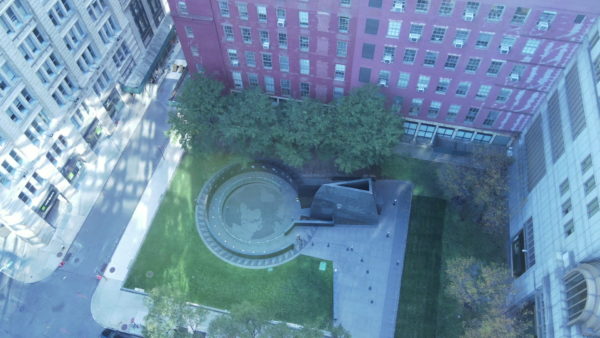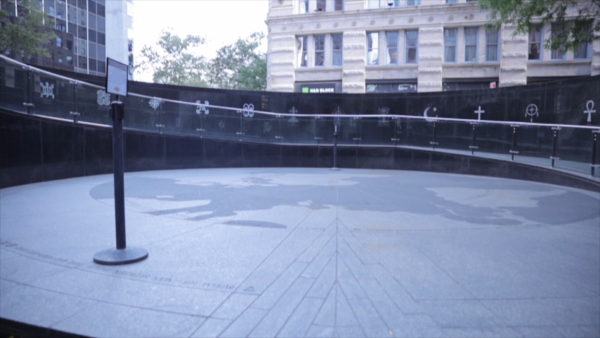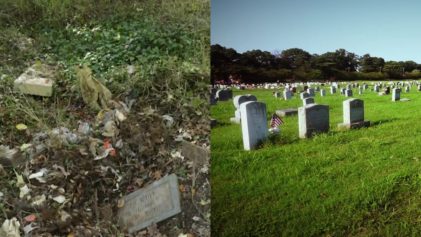The African Burial Ground National Monument in lower Manhattan, New York, is the oldest and largest known such burial ground excavated in North America.
In 1991 an archaeological crew surveying the site of a proposed new $275 million federal office building dug up more than 400 skeletons.
The bodies were mostly those of enslaved Africans who built New York City, who for years were forgotten — their memories and contributions erased.
Experts say there are roughly 15,000 bodies interred in a 6.6-acre plot of land covered by centuries of construction and landfill. Enslaved people provided essential labor for what would become present-day New York City.
Between the 1690s to the 1790s, the small plot served as a final resting place for free and enslaved Africans. A 1758 map showed an African burial ground, but years later the ground’s indicator was removed from the map.
“It was shut down in the late 1700s and it was at the base of a ravine with a mountain above it. They took the dirt from the mountain above and they covered this ravine and made this area flat,” said U.S. Park Ranger, Eliza Rasmussen, as she gave Atlanta Black Star a tour of the sacred land. “At this point, the burial ground starts to be forgotten about. They actually end up building on top of it.”
It was a time when slavery was an American institution that reached farther than just the South. Records of enslavement of people of African descent extend back to the 17th century when present-day New York was still a Dutch colony, and the practice continued under the English and later the Americans until it was outlawed in the state in 1825.
“There were historians teaching in universities who would argue or who simply assumed or thought slavery did not exist in the North,” Michael Blakey said.
Blakey was the principal investigator and scientific director of the National African and Burial Ground Project. All the research was under his direction. As bioarcheologists, Blakey and his team from Howard University in Washington examined and interpreted the skeletons for evidence of quality-of-life, origins, health differences, and any artifacts.

“This was the largest African-American cemetery that was coming available for study and we would find that there were 419 individuals in the end,” Blakey recalled.
The goal was to take a census in epidemiology, an investigation to better understand how the people found at the site might have lived and died.
“What we could glean about them as human beings and the artifacts that were carefully buried with them showed how much they care about one another,” Blakey remarked. “It humanizes not just the people of the past but their descendants.”
The 419 bodies and over 500 individual artifacts were revealed under the surface. The bioarcheologists combing through the site estimate, based on density and the number of remains that were found, there are anywhere from 15,000 to 20,000 people buried there.
While officials began trying to work out what to do with the newfound bodies, the community did not sit by idly. There were protests and prayer vigils calling for the construction to be canceled.

“The African-American community, alerted by a press conference in Fall of 1991, became immediately incensed at what was clearly an African Cemetery that probably began use in the 1600s and was used throughout the 1700s was being desecrated — that was their assessment of it — for the purposes of building an office tower,” said Blakey.
According to Blakey, their were grievances were around disturbing the bones at all.
“One of the things I recognized as an anthropologist is that human beings are partly defined by our memorialization of the dead,” Blakey said. “That’s my interpretation of the many different ways in which African Americans especially were offended by the disturbance of the remains and by the destruction of the site and racism was also continuously in the air as it is today in most of the United States.”
Ultimately, the African Burial Ground became a national historic landmark in 1993 and a national monument in 2006. Still, the lack of names and face as you venture through the site is a cold reminder that what can be remembered of these people is based on their sex and apparent ages– about half who were children whose lives were snatched from them as their families were snatched from the shores of Africa.
“We wanted a whole museum for our people because really there were 20,000 people in that area of our people buried. 20,000,” exclaimed Charles Barron, who is a member of the New York state Assembly and founding member of Operation Power.
Barron was also one of the major champions of preserving the site and reinterring those who made up around three percent of the New York population in their time. Barron says Black peoples’ stake in America has worsened since slavery.
“We don’t have any place in the most powerful city in the world with a $170 or $180 billion state budget and a $90 billion dollar city budget,” Barron said. “If you measure progress from slavery everything looks like we made progress,” Barron explained “No, we’re not on the plantation. Just like we’re not riding horses and buggies. You want to talk about the progress — we regressed!”
Barron and others like him say, it is not the wars, the groundbreaking discoveries, or financial wealth that birthed America. It is the black bodies that continuously go overlooked and written out of history. Currently, the burial ground is closed and only open for virtual tours led by park rangers.

